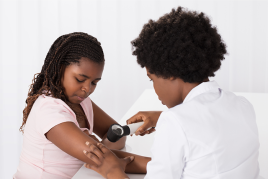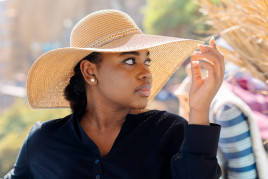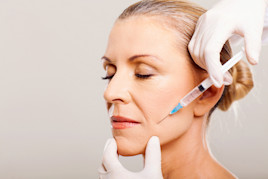Rosacea: Overview
What is rosacea?
Rosacea
Rosacea is a skin condition that mainly affects the face. You may see flushing, lasting color (red, violet, or brown), acne-like breakouts, or visible blood vessels. Some people develop irritated eyes or thickening skin. Your dermatologist knows how to diagnose rosacea and create a treatment plan that can bring relief.
Is rosacea contagious? No.
 Rosacea develops in people of all skin tones
Rosacea develops in people of all skin tones
People with lighter skin tones often develop redness (left), and people with darker skin tones may see a brown or violet color (right) on their face.
How can you tell if you flush frequently or have rosacea?
We flush for many reasons. You may notice flushing when you feel embarrassed, get overheated, drink alcohol, or spend time outdoors on a cold or windy day. Flushing comes and goes, clearing within a few hours or less.
If you have rosacea, the redness or violet color lasts longer. The color can become more noticeable when something triggers it, like when you apply certain skin care products to your face or drink red wine.
While flushing and rosacea differ, rosacea often begins with a tendency to flush. If you flush more often than before or the color (or warm sensation) lasts longer and longer, you might have rosacea.
People mistake rosacea for acne, sunburn, or a skin reaction
Do you have acne-like breakouts that nothing seems to clear? Are you bothered by frequent sunburns on your face? Does your face often feel warm? When you apply certain skin care products, does your skin sting or burn? If you answered “yes” to these questions, you might have rosacea.
To find out what’s causing your skin condition, the American Academy of Dermatology recommends that you see a board-certified dermatologist. Rosacea can be mistaken for rosy cheeks. It can also look like another skin condition, including eczema or seborrheic dermatitis. Your dermatologist knows how to diagnose and treat over 3,000 conditions that affect the skin, hair, or nails.
If you have rosacea, treatment can prevent the condition from worsening. The medical term for this is “progressing.” The more rosacea progresses, the more difficult it becomes to treat. Rosacea can also affect your eyes causing them to be dry and irritated.
Can rosacea be cured?
At this time, there is no cure for rosacea.Treatment can reduce flare-ups and help you feel more comfortable. A treatment plan usually consists of:
Following rosacea friendly skin care
Avoiding what triggers your flare-ups
Treatment for the signs and symptoms, such as acne-like breakouts and burning or stinging
What can clear rosacea fast?
A few prescription medications can fade the persistent color quickly. Most patients see their best results 3 to 6 hours after applying the medication to their face. The fading can last for up to 12 hours before the color starts to return. Your dermatologist can tell you if this medication is right for you.
Other treatments take longer to show results. Following your treatment plan is the best way to reduce (or get rid of) signs of rosacea like acne-like breakouts and visible blood vessels.
While your skin heals, you can use makeup if desired. A yellow-tinted concealer can mask discoloration on skin tones ranging from light to dark. A green-tinted concealer can camouflage redness.
Keep in mind that some makeup can irritate your sensitive skin. That’s why dermatologists often recommend water-based or powder makeup, which usually doesn’t irritate rosacea.
Why does rosacea worsen at times and then get better?
Rosacea is a condition that flares and then calms down. Your dermatologist may call these “exacerbations” (flares) and "remissions" (calms down).
When anything irritates the sensitive skin of rosacea, you can experience a flare. As the flare subsides, people say their skin gets better.
People often say that rosacea flares unexpectedly. It can feel like this because so much can irritate their skin.
Anything that causes a flare is called a “trigger,”and triggers can be different for everyone. Keeping a daily journal can help you find your triggers, so you can avoid them.
You can start finding your triggers today with this checklist of common rosacea triggers, which is included in the Rosacea Diary from the National Rosacea Society. In this diary, you’ll also find space to write down other irritants that could be triggering your flare-ups.
What does rosacea look like?
Rosacea can cause more than rosy cheeks, brown or violet discoloration on your face, or acne-like breakouts. You’ll find more information and pictures at Rosacea: Signs and symptoms.
Images
Image 1: Produced with permission from ©DermNet www.dermnetnz.org 2024.
Image 2: Getty Images
References
Gallo RL, Granstein RD, et al. "Standard classification and pathophysiology of rosacea: The 2017 update by the National Rosacea Society Expert Committee.” J Am Acad Dermatol. 2018 Jan;78(1):148-55.
Thiboutot D, Anderson R, et al. “Standard management options for rosacea: The 2019 update by the National Rosacea Society Expert Committee.” J Am Acad Dermatol. 2020 Jun;82(6):1501-10.
van Zuuren EJ, Arents BWM, et al. “Rosacea: New concepts in classification and treatment.” Am J Clin Dermatol. 2021 Jul;22(4):457-65.
Written by:
Paula Ludmann, MS
Reviewed by:
Elan M. Newman, MD, FAAD
Rajiv I. Nijhawan, MD, FAAD
Brittany Oliver, MD, FAAD
Last updated: 4/3/24
 Molluscum contagiosum: How to safely treat it
Molluscum contagiosum: How to safely treat it
 Biosimilars: 14 FAQs
Biosimilars: 14 FAQs
 Practice Safe Sun
Practice Safe Sun
 Relieve uncontrollably itchy skin
Relieve uncontrollably itchy skin
 Fade dark spots
Fade dark spots
 Untreatable razor bumps or acne?
Untreatable razor bumps or acne?
 Laser hair removal
Laser hair removal
 Scar treatment
Scar treatment
 Botox
Botox
 Free materials to help raise skin cancer awareness
Free materials to help raise skin cancer awareness
 Dermatologist-approved lesson plans, activities you can use
Dermatologist-approved lesson plans, activities you can use
 Find a Dermatologist
Find a Dermatologist
 What is a dermatologist?
What is a dermatologist?